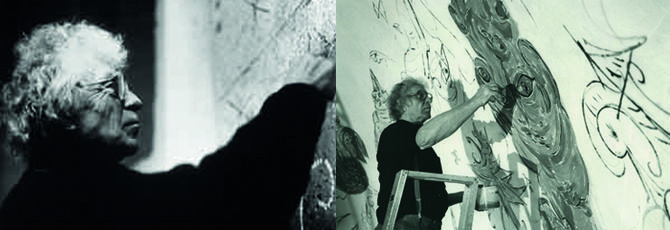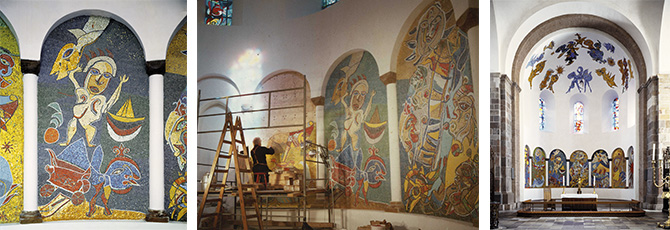Ribe Cathedral
In the early 1980s, Carl-Henning Pedersen was chosen by the Danish Arts Foundation to decorate Ribe Cathedral, one of Denmark's oldest and most beautiful churches. This would prove a controversial choice. The proposed combination of modern expressionist painting with the “noblest church interior of the Romanesque period” was considered problematic in and of itself, but to choose an artist such as Carl-Henning Pedersen, who was not a Christian in the traditional sense, did by no means lessen the indignation felt by many.

Photos: Sidsel Ramson
A public debate began in June 1982 when the first contribution was published in the Politiken newspaper. The debate continued through the summer with arguments both for and against having Carl-Henning Pedersen's art decorate not only the church walls but the most sacred parts of the church: The choir and the apsis. Arguments of support for the choice of Pedersen for the assignment eventually won out, and in 1983 Carl-Henning Pedersen began the five-year-long process of creating frescos, mosaics and stained-glass windows for Ribe Cathedral.
Upon his death in 2007, Carl-Henning Pedersen left behind a diary covering his time in Ribe, committing to paper his many thoughts, inspirations, techniques, and worries in connection with the assignment. “A church painter I shall never be,” he wrote in one of his first entries, but it is a clearly inspired Carl-Henning Pedersen who later relates one of his most powerful experiences while working on the frescos:
“There I was, high up, my head bent backwards, gazing out into the interior of the church, and feeling as if I was standing beneath the great vault of the sky – and perhaps feeling a little lost. Then suddenly the organ set in, the organist playing, and it was as if the brush in my hand felt lighter, and I began to draw – a free composition – which I like to call “Concerning the Mystery of Existence”".
Carl-Henning Pedersen had made more than a hundred preparatory sketches for the interior of the church, but as the quotation above demonstrates it was not until the actual execution of the work that the decorations found their final form.

Photos: Finn Roosted